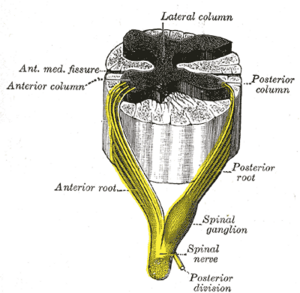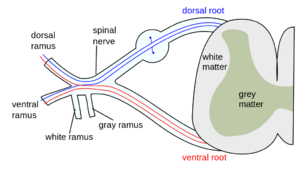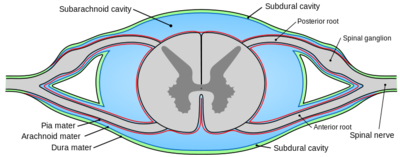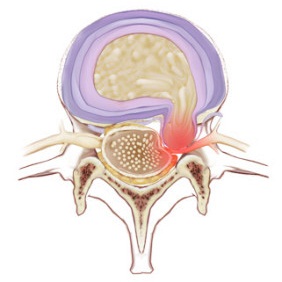Thoracic Spinal Nerves: Difference between revisions
No edit summary |
Kim Jackson (talk | contribs) m (Text replacement - "[[Brachial plexus|" to "[[Brachial Plexus|") |
||
| (13 intermediate revisions by 2 users not shown) | |||
| Line 1: | Line 1: | ||
<div class="editorbox"> | <div class="editorbox"> | ||
'''Original Editor '''- [[User: | '''Original Editor '''- [[User:Lucinda hampton|Lucinda Hampton]] | ||
'''Top Contributors''' - {{Special:Contributors/{{FULLPAGENAME}}}} | '''Top Contributors''' - {{Special:Contributors/{{FULLPAGENAME}}}} | ||
</div> | </div> | ||
== Introduction == | == Introduction == | ||
[[File:Spinal nerve formation.png|thumb|Spinal nerve formation]] | |||
There are 12 pairs of [[Spinal Nerves|spinal nerves]] that originate from the thoracic segments of the [[Spinal cord anatomy|spinal cord]]. These nerves mainly supply the skin over the chest and intrinsic [[Back Muscles|back muscles]] of the thoracolumbar region. The thoracic nerves also supply some of the areas of skin over the abdomen and axilla. | |||
Spinal nerves are essential for the control of body parts by the central nervous system. If any spinal nerve is cut, trapped, injured, or is involved in a disease process, the areas of the body supplied by the spinal nerve suffer pain, sensation loss and/or weakness<ref>Maryland back and neck doctors Thoracic spine damage Available:https://www.marylandbackandneckpaindoctors.com/symptoms-of-thoracic-spine-nerve-damage/ (accessed 7,2,2022)</ref>. | |||
== Anatomy == | |||
[[File:Spinal nerve.png|thumb|Spinal Nerve]] | |||
The [[Thoracic Anatomy|thoracic spine]] has: | |||
= | # 12 nerve roots (T1 to T12) on each side of the spine that branch from the [[Spinal cord anatomy|spinal cord]]. | ||
# Each thoracic spinal nerve is named for the vertebra above it. eg the T4 nerve root runs between the T4 vertebra and T5 vertebra.<ref name=":0">Spine Health [https://www.spine-health.com/conditions/upper-back-pain/thoracic-spinal-nerves Thoracic Spinal Nerves] Available from:https://www.spine-health.com/conditions/upper-back-pain/thoracic-spinal-nerves (last accessed 7.5.2020)</ref> | |||
Each thoracic nerve root exits the spinal canal through an intervertebral foramen (formed by two adjacent vertebrae, and its size and shape can slightly shift as the vertebrae move).[[File:Cross section spinal cord.png|400x400px|alt=|thumb|Cross section spinal cord]]Each spinal nerve is formed by the combination of nerve fibers from the dorsal and ventral roots of the spinal cord. | |||
# The dorsal roots carry afferent sensory axons | |||
The | # The ventral roots carry efferent motor axons. | ||
The spinal nerve emerges from the spinal column through in the intervertebral foramen between adjacent vertebrae, where it is surrounded by the dura mater. | |||
Each spinal nerve is a mixed nerve that contains afferent and efferent, somatic and autonomic fibers. | |||
After branching from the spinal cord and travelling through the foramen, a thoracic nerve root branches into two different nerve bundles that feed into the rami ie ventral ramus (to ventral part of trunk) and dorsal ramus (to dorsal part of trunk). For more details see [[Spinal Nerves]]. | |||
== | == Supply Areas == | ||
Thoracic spinal nerves serve the region thus: | |||
* T1 and T2 (top two thoracic nerves) feed into nerves that go into the top of the chest as well as into the arm and hand. T1 is also part of the [[Brachial Plexus|Brachial Plexus]]. | |||
* T3, T4, and T5 feed into the chest wall and aid in [[Phrenic Nerve|breathing]]. | |||
* T6, T7, and T8 can feed into the chest and/or down into the abdomen. | |||
* T9, T10, T11, and T12 can feed into the abdomen and/or lower in the back.<ref name=":1">Imaios [https://www.imaios.com/en/e-Anatomy/Anatomical-Parts/Thoracic-nerves-T1-T12 Thoracic Nerves] Available from: https://www.imaios.com/en/e-Anatomy/Anatomical-Parts/Thoracic-nerves-T1-T12 (last accessed 7.5.2020)</ref> | |||
== Clinical | The meningeal branches (recurrent meningeal or sinuvertebral nerves) branch from the spinal nerve and re-enter the intervertebral foramen to serve the [[Ligament|ligaments]], dura, blood vessels, [[Intervertebral disc|intervertebral discs]], [[Facet Joints|facet joints]], and [[periosteum]] of the vertebrae.<ref name=":2">lumenlearning [https://courses.lumenlearning.com/boundless-ap/chapter/spinal-nerves/ spinal nerves] Available from:https://courses.lumenlearning.com/boundless-ap/chapter/spinal-nerves/ (last accessed 7.5.2020)</ref> | ||
== Clinical Relevance == | |||
[[File:Sam-burriss-zHSX9o2 B7Y-unsplash.jpg|right|frameless|300x300px]]Each vertebra in the spine is associated with the nerves that are in that section of the [[Spinal cord anatomy|spinal cord]]. If any of these large nerve roots become compressed, irritated or damaged, pain and functional issues can develop. | |||
# Natural reasons for thoracic spine nerve damage include a herniated disc, thoracic radiculopathy, or a narrowing of the foramen. | |||
# External reasons for nerve damage include blunt-force trauma and surgery. | |||
[[File:Disc extrusion.jpg|thumb|Disc herniation]] | |||
The below are more examples of disfunction of thoracic spinal nerves | |||
= | #[[Thoracic Disc Syndrome|Thoracic herniated disc,]] leading to [[Thoracic Radiculopathy|thoracic radiculopathy]], with symptoms of pain, tingling, numbness, and/or weakness radiating along the nerve root. | ||
#*These symptoms typically follow a pattern as noted above, based on the affected nerve root’s location and functions. eg, T3 [[radiculopathy]] could radiate pain and other symptoms into the chest via the branch of the nerve root that becomes an intercostal nerve traveling along the route between the third and fourth ribs. If the branch of the thoracic nerve going toward the back becomes inflamed, pain and other symptoms could be felt in the back at or near the location of the inflammation<ref name=":0" />. | |||
#A severe [[Muscle Strain|strain]] of a [[muscle]] between ribs (intercostal muscle) or a [[Slipping Rib Syndrome|slipping rib]], can cause an intercostal nerve to become inflamed, painful, and possibly make breathing more difficult and certain movements painful. | |||
#[[Spinal Cord Injury]] - if a vertebra is fractured by trauma, eg motor vehicle accident or gunshot wound a spinal cord injury may result | |||
#* Spinal cord injuries are usually classified based on the spinal nerve root level where function is reduced or completely lost. For example, a T6 spinal cord injury would impair or lose function at the T6 nerve root level and below. In this case, the person would likely have full use of the arms and breathing ability, but may have weakness, numbness, and other problems in the abdominal area and below, such as paralysis of both legs and bowel/[[Bladder Management in Spinal Cord Injury|bladder]] dysfunction. | |||
== References | == References == | ||
<references /> | <references /> | ||
| Line 56: | Line 57: | ||
[[Category:Anatomy]] | [[Category:Anatomy]] | ||
[[Category:Nerves]] | [[Category:Nerves]] | ||
[[Category:Thoracic Spine]] | |||
[[Category:Thoracic Spine - Nerves]] | |||
[[Category:Thoracic Spine - Anatomy]] | |||
Latest revision as of 18:59, 8 March 2024
Original Editor - Lucinda Hampton
Top Contributors - Lucinda hampton and Kim Jackson
Introduction[edit | edit source]
There are 12 pairs of spinal nerves that originate from the thoracic segments of the spinal cord. These nerves mainly supply the skin over the chest and intrinsic back muscles of the thoracolumbar region. The thoracic nerves also supply some of the areas of skin over the abdomen and axilla.
Spinal nerves are essential for the control of body parts by the central nervous system. If any spinal nerve is cut, trapped, injured, or is involved in a disease process, the areas of the body supplied by the spinal nerve suffer pain, sensation loss and/or weakness[1].
Anatomy[edit | edit source]
The thoracic spine has:
- 12 nerve roots (T1 to T12) on each side of the spine that branch from the spinal cord.
- Each thoracic spinal nerve is named for the vertebra above it. eg the T4 nerve root runs between the T4 vertebra and T5 vertebra.[2]
Each thoracic nerve root exits the spinal canal through an intervertebral foramen (formed by two adjacent vertebrae, and its size and shape can slightly shift as the vertebrae move).
Each spinal nerve is formed by the combination of nerve fibers from the dorsal and ventral roots of the spinal cord.
- The dorsal roots carry afferent sensory axons
- The ventral roots carry efferent motor axons.
The spinal nerve emerges from the spinal column through in the intervertebral foramen between adjacent vertebrae, where it is surrounded by the dura mater.
Each spinal nerve is a mixed nerve that contains afferent and efferent, somatic and autonomic fibers.
After branching from the spinal cord and travelling through the foramen, a thoracic nerve root branches into two different nerve bundles that feed into the rami ie ventral ramus (to ventral part of trunk) and dorsal ramus (to dorsal part of trunk). For more details see Spinal Nerves.
Supply Areas[edit | edit source]
Thoracic spinal nerves serve the region thus:
- T1 and T2 (top two thoracic nerves) feed into nerves that go into the top of the chest as well as into the arm and hand. T1 is also part of the Brachial Plexus.
- T3, T4, and T5 feed into the chest wall and aid in breathing.
- T6, T7, and T8 can feed into the chest and/or down into the abdomen.
- T9, T10, T11, and T12 can feed into the abdomen and/or lower in the back.[3]
The meningeal branches (recurrent meningeal or sinuvertebral nerves) branch from the spinal nerve and re-enter the intervertebral foramen to serve the ligaments, dura, blood vessels, intervertebral discs, facet joints, and periosteum of the vertebrae.[4]
Clinical Relevance[edit | edit source]
Each vertebra in the spine is associated with the nerves that are in that section of the spinal cord. If any of these large nerve roots become compressed, irritated or damaged, pain and functional issues can develop.
- Natural reasons for thoracic spine nerve damage include a herniated disc, thoracic radiculopathy, or a narrowing of the foramen.
- External reasons for nerve damage include blunt-force trauma and surgery.
The below are more examples of disfunction of thoracic spinal nerves
- Thoracic herniated disc, leading to thoracic radiculopathy, with symptoms of pain, tingling, numbness, and/or weakness radiating along the nerve root.
- These symptoms typically follow a pattern as noted above, based on the affected nerve root’s location and functions. eg, T3 radiculopathy could radiate pain and other symptoms into the chest via the branch of the nerve root that becomes an intercostal nerve traveling along the route between the third and fourth ribs. If the branch of the thoracic nerve going toward the back becomes inflamed, pain and other symptoms could be felt in the back at or near the location of the inflammation[2].
- A severe strain of a muscle between ribs (intercostal muscle) or a slipping rib, can cause an intercostal nerve to become inflamed, painful, and possibly make breathing more difficult and certain movements painful.
- Spinal Cord Injury - if a vertebra is fractured by trauma, eg motor vehicle accident or gunshot wound a spinal cord injury may result
- Spinal cord injuries are usually classified based on the spinal nerve root level where function is reduced or completely lost. For example, a T6 spinal cord injury would impair or lose function at the T6 nerve root level and below. In this case, the person would likely have full use of the arms and breathing ability, but may have weakness, numbness, and other problems in the abdominal area and below, such as paralysis of both legs and bowel/bladder dysfunction.
References[edit | edit source]
- ↑ Maryland back and neck doctors Thoracic spine damage Available:https://www.marylandbackandneckpaindoctors.com/symptoms-of-thoracic-spine-nerve-damage/ (accessed 7,2,2022)
- ↑ 2.0 2.1 Spine Health Thoracic Spinal Nerves Available from:https://www.spine-health.com/conditions/upper-back-pain/thoracic-spinal-nerves (last accessed 7.5.2020)
- ↑ Imaios Thoracic Nerves Available from: https://www.imaios.com/en/e-Anatomy/Anatomical-Parts/Thoracic-nerves-T1-T12 (last accessed 7.5.2020)
- ↑ lumenlearning spinal nerves Available from:https://courses.lumenlearning.com/boundless-ap/chapter/spinal-nerves/ (last accessed 7.5.2020)











